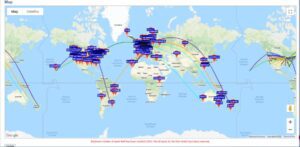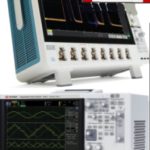The Australian edition of the TV show 60 Minutes recently aired a piece involving retired British Aerospace engineer Richard Godfrey who says he knows where the Malaysian Airlines Flight MH370 went down eight years ago. Godfrey told 60 Minutes he used an amateur radio technology called Weak Signal Propagation Reporter (WSPR) to track the airliner’s path via signal disturbances.
Immediately after the broadcast there was a lot of pooh-poohing of the idea that WSPR records can be useful this way. In actuality, Godfrey first presented his ideas in May 2021, and debate about them has raged since then. Here’s a brief explanation of WSPR and how Godfrey says he uses it (along with some satellite data) to predict the crash site. We’ll also cover some of the main objections to the theory.

WSPRnet data goes back to 2008. The key development that gave credence to the idea of detecting MH370 with WSPRnet data was a study by Robert Westphal in Germany who detected several aircraft in Antarctica such as a B787-9, two Dassault Falcon 900EX, an Ilyushin IL76TD and a DC3C commuter airplane via WSPR tests. Westphal said testing in Antarctica was preferred as a way to avoid ambiguities with other aircraft as can happen in crowded air space. Westphal also was able to realize detection ranges of more than 7,500 km from Antarctica to New Zealand.
Westphal suggested a similar approach for MH370 because data about it is recorded in the WSPR database for the the entire eight-hour flight with signals from 7 MHz to 28 MHz, with signals coming from operators in Europe, Asia, North and South America as well as Australia and New Zealand.
Godfrey says the WSPR database contains 91,058 spots and 11,753 unique transmitter receiver links. Often transmitters will automatically send multiple transmissions at the same time which are picked up by over 20 different receivers around the globe. Godfrey says it is possible to see signal anomalies in this data over the timeframe of MH370 and on other days before and after the MH370 timeframe, as well as across the globe from the same transmitter at a particular time. The transmitted power ranges from 0 dBm to 50 dBm; the frequency bands range from 1 MHz to 28 MHz, the propagation distance ranges from 500 km to 19,437 km and the SNR ranges from – 33 dB to + 17 dB. Each transmitted power and each frequency band has to be treated separately. Each transmitter and each receiver and each link between them has to be treated separately. There are different antennas used and different terrain profiles at each location.

Godfrey calls the process outlined above GDTAAA (Global Detection and Tracking of Any Aircraft Anywhere). GDTAAA comprises the code generator that produces data for the Matlab function, the import of Matlab scripts for the relevant timeframe and the Matlab template script for graphical presentation. The software architecture comprises the WSPRnet data exported to Microsoft Excel, the ADS-B data exported to Microsoft Access, the Flight Path Model in Microsoft Excel, the Template Generator in Matlab R2021b, the Function Call Code Generator in Microsoft Excel and imported into the Matlab Script produced by the Template Generator and executed in the Matlab Function and the Propagation Path Analysis in Proplab Pro V3.1. Godfrey says te analysis of the GDTAAA output and the analysis of the Proplab Pro V3.1 output is manual.
Criticisms of Godfrey’s method generally center on the WSPR path accuracy. Some say deductions from WSPR data would only be true for paths traveling less than about one-third of the way around the globe. The mental exercise that shows the problem is to assume there are WSPR transmission and reception sites exactly 180° apart at specific points on the Earth that are directly opposite each other. There is no shortest path, and a signal would likely have followed the more highly ionized layers related to the terminator and Earth’s magnetic field lines. The potential flaw in the analysis lies in assuming the signal is equally likely to follow an extension of the shortest great circle path that only takes the long way around the Earth.
Critics say there was only one short global WSPR path during the MH370 flight. They claim that all the others in Godfrey’s analysis were long-path projections that just happen to confirm his candidate crash site. They further claim there can be no expectation of any accuracy for paths going three-quarters of the way around the globe. In a nutshell, critics say that Godfrey’s method needs a regular stream of signal reports to work, and that stream can only come from the shortest of global paths. But at the same time, the analysis assumes that each contact signal has taken the longest possible path around the globe via numerous skips, yet retaining the accuracy of a single skip or two.
Of course, today the arguments for and against Godfrey’s analysis are all theoretical. The proof will be either a crash site or the bottom of the ocean with nothing on it but sand.






Leave a Reply
You must be logged in to post a comment.